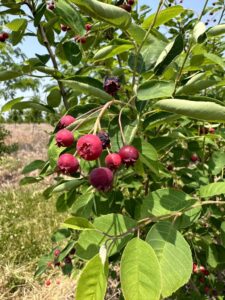
Serviceberry Fruits Perfectly Ripe
~ June 1, 2025
The month of June settles us into a summer routine here at the nursery. Our days are spent pruning & staking trees and tending to farmland maintenance. Each year we are always surprised by how quickly we find ourselves in June! With the changing of the seasons come changes around the farm, namely lots of blooms and berries popping up on our trees! One of our favorite signs that summer is here is the arrival of delicious Serviceberry fruits. We had fun out in the field picking buckets of ripe Serviceberries to make into baked goods, jam, and even flavored ice cream. Our time in the trees led to us wanting to learn more about the history of the Serviceberry.
The Autumn Brilliance Serviceberry brings beauty across all seasons, which makes it one of our favorite trees at the nursery! With delicate white spring flowers followed by edible red fruits in June, to a fiery red-orange glow in the fall and smooth gray branches adding winter interest along with a strong structure that resists ice breakage the Serviceberry is a versatile and excellent Midwest Native tree. Serviceberry performs well in our field; we grow both single trunk and multi-stem versions. It has a slow start as a young plant but it finishes strong. The single trunk form takes a little longer to caliper up than the multi-stem. We love how this tree has something interesting to offer in every season – especially in the summer when the berries are a nice treat in the field!
In researching more about how the Serviceberry gets its name, we came across an interesting origin story. When Europeans were first colonizing North America they dealt with difficult and long winters, often leading to many people dying over the harsh winter months. They needed to wait until the ground thawed to bury the dead, and it was with the thaw that the itinerant pastors and priests could travel to each settlement to perform their religious burial rites. By the time the Serviceberry trees blossomed was when the ground had thawed and the priests could make the trek out. Once they safely made it they performed Services of burial, marriage, and baptism to cover the winter months.
This story is likely just a myth, with the true meaning of the name coming from what etymologists call a loanword. “Loanwords are words borrowed from other languages, and many of these sound similar to words that already exist in the language. The name initially applied to another species in a different genus. Sorbus, which comes from the Proto-Indo-European stem ‘sor’ and means red, sounds similar to service, so that’s where we get ‘service.’ The red part of ‘sorbus’ refers to the brilliant red fruits of Rowan, or mountain ash, Sorbus aucuparia. So there you have it, the true meaning of the name: red berry!”
If you’re able to go out and harvest the berries there’s lots of delicious desserts and jams you can make with them to enjoy the fruits of your labor. Once ripe, Serviceberry is, “reminiscent of the blueberry enhanced by the almond flavor of the seeds, [with] a sweet, nutty taste,” so you can substitute them into cobbler, crisps, muffins, and pies. We made this delicious fridge jam to eat with breakfast, warmed brie and crackers, and plan to mix it into ice cream to make a fruity homemade ice cream sandwich.
Aside from just eating the berries, Serviceberry offers other uses and medicinal value. Different North American Indigenous tribes used Serviceberries in a variety of ways. “Tribes of the northern Great Plains, such as the Cree and the Ojibwa, gathered the berries drying them in the sun to make cakes for winter provisions. The Native American trail food pemmican, a concoction made from dried lean meat and animal fat, was typically flavored with Saskatoon (Service) berries.” Other uses for the tree include, “the wood [that] was crafted into a corset or heavy robe to use as body armor. Young stems and branches were made into arrows, ropes and baskets.” Additionally, “in Canada, the fruits are used as juice for treating stomach ailments and as a laxative. Eye- and ear-drops are also prepared from ripe serviceberries. The boiled bark is used as a disinfectant, while the root infusion is used to prevent miscarriage after an injury. Native American communities prepare tea from the twigs and stem and administer it to women just after childbirth. Moreover, a tonic from the bark is given to women after delivery to hasten discharge of the placenta.” Research from the NIH shows, “there is a growing interest in novel or less well-known foods that offer an opportunity for health maintenance. This study demonstrated that serviceberry fruits present a plethora of phytochemicals with the capacity to promote health and protect against chronic diseases.”
In the excellent book The Serviceberry: Abundance and Reciprocity in the Natural World, Indigenous author Robin Wall Kimmerer (author of Braiding Sweetgrass: Indigenous Wisdom, Scientific Knowledge and the Teachings of Plants) writes about the “ethic of reciprocity” that challenges us to see ourselves as interconnected to the natural world, in tune with the cycles and rhythms of nature. Serviceberry shows us a model of living that is rooted in what she describes as the “gift economy,” based upon, “reciprocity rather than accumulation.” Serviceberry, Kimmerer writes, “[provides] a myriad of goods and services. Not only to humans but to many other citizens. It is a preferred browse of Deer and Moose, a vital source of early pollen for newly emerging insects, and host to a suite of butterfly larvae—like Tiger Swallowtails, Viceroys, Admirals, and Hairstreaks—and berry-feasting birds who rely on those calories in breeding season.”
Here is another excerpt from her book that reminds us of our place in the ecosystem:
“With my fingers sticky with berry juice, I’m reminded that my life is contingent upon the lives of others, without whom, I simply would not exist. Water is life, food is life, soil is life–and they become our lives through the paired miracles of photosynthesis and respiration. All that we need to live flows through the land. It is not an empty metaphor that we call her Mother Earth. Food in our mouths is the thread that connects us in a relationship simultaneously spiritual and physical, as our bodies get fed and our spirits nourished by the sense of belonging, which is the most vital of foods.
I have no claim to these berries, and yet here they are in my bucket, a gift.
This pail of Juneberries represents hundreds of gift exchanges that led up to my blue-stained fingers: the Maples who gave their leaves to the soil, the countless invertebrates and microbes who exchanged nutrients and energy to build the humus in which a Serviceberry seed could take root, the Cedar Waxwing who dropped the seed, the sun, the rain, the early spring flies who pollinated the flowers, the farmer who wielded the shovel to tenderly settle the seedlings. They are all parts of the gift exchange by which everyone gets what they need.”
I could keep quoting this book until I’ve shared the entire manuscript–it’s that good! It challenges us to think of our human economies reimagined and modeled after ecological systems that meet citizens’ needs while aligning with ecological principles that allow long-term sustainability for people and for the planet. Robin Wall Kimmerer’s writing poses the question: What if we shifted how we saw the world from a market economy to a gift economy? Would that change how we interact with each other and the natural world? She gives the example of receiving a handknit hat vs. buying a mass-produced hat at the store, and writes, “you’re likely to take much better care of the gift hat than of the commodity hat, because the gift hat is knit of relationships. This is the power of gift thinking. I imagine if we acknowledged that everything we consume is the gift of Mother Earth, we would take better care of what we are given.” We have much to learn from this Indigenous wisdom.
You can grab a copy of her book anywhere books are sold, listen via audiobook, or stop by our Nursery office and borrow a hard copy to read and then pass along to share with a friend!
There is a lot of interesting research and discussion out there about the history and future of the Serviceberry tree and its fruits. We encourage you to keep learning more about this Midwest Native tree we all know and love, and try out some of the recipes or uses for yourself! Let us know if you make or bake anything delicious with your Serviceberries, or if you just like to appreciate the seasonal beauty of this SGN Tried-and-True tree! Little Fern said it best in the video we’ll share below from berry picking a few summers ago: “Ooooooooo BERRIES!”
~ Maggie Thomas Harper
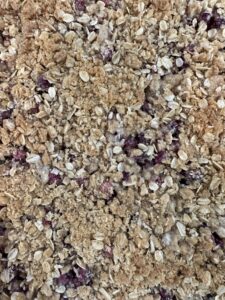
Serviceberry Crisp
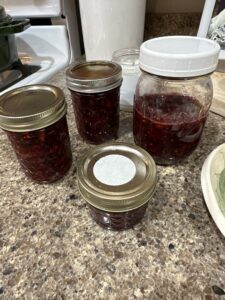
Serviceberry Jam

Serviceberry Jam with Lavender and Sage Blossoms
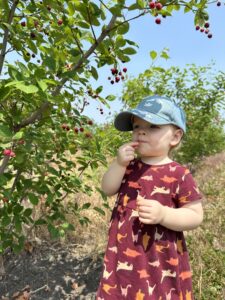
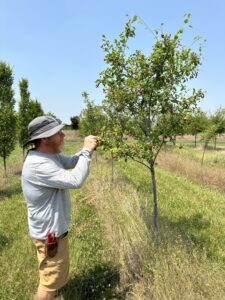
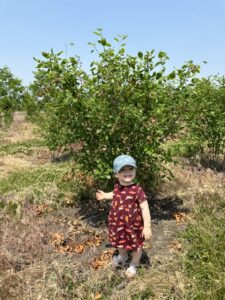
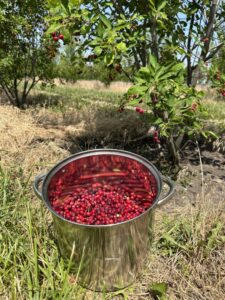

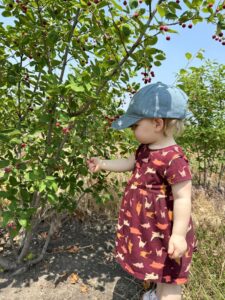
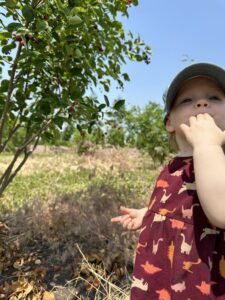
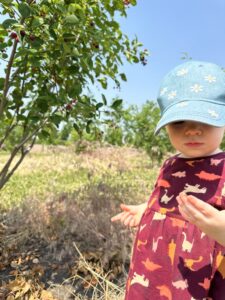






Where can I purchase a serviceberry tree in the uk?